CADILLAC XLR 2005 1.G Owners Manual
Manufacturer: CADILLAC, Model Year: 2005, Model line: XLR, Model: CADILLAC XLR 2005 1.GPages: 438, PDF Size: 3.69 MB
Page 371 of 438
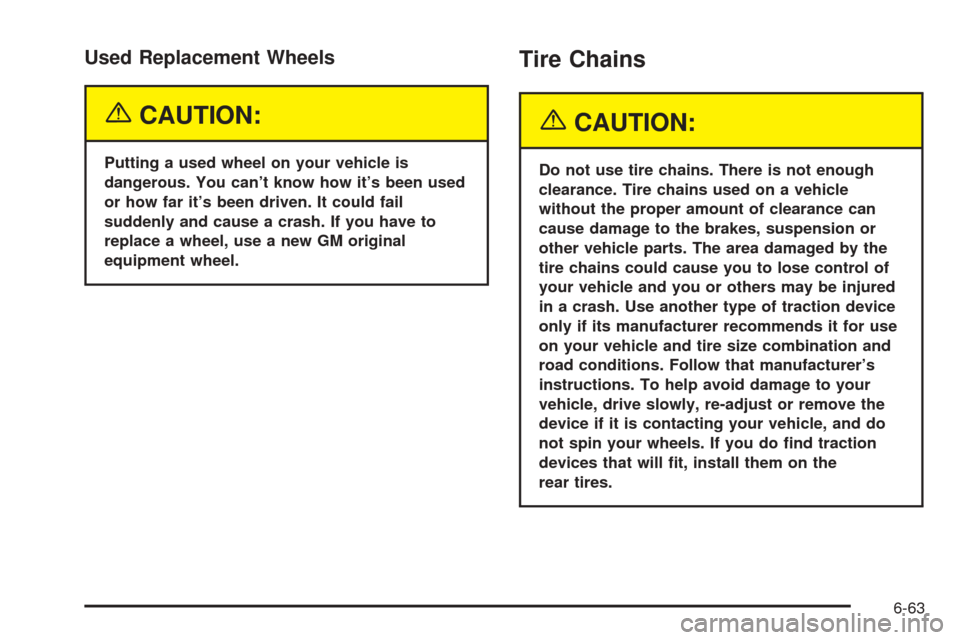
Used Replacement Wheels
{CAUTION:
Putting a used wheel on your vehicle is
dangerous. You can’t know how it’s been used
or how far it’s been driven. It could fail
suddenly and cause a crash. If you have to
replace a wheel, use a new GM original
equipment wheel.
Tire Chains
{CAUTION:
Do not use tire chains. There is not enough
clearance. Tire chains used on a vehicle
without the proper amount of clearance can
cause damage to the brakes, suspension or
other vehicle parts. The area damaged by the
tire chains could cause you to lose control of
your vehicle and you or others may be injured
in a crash. Use another type of traction device
only if its manufacturer recommends it for use
on your vehicle and tire size combination and
road conditions. Follow that manufacturer’s
instructions. To help avoid damage to your
vehicle, drive slowly, re-adjust or remove the
device if it is contacting your vehicle, and do
not spin your wheels. If you do �nd traction
devices that will �t, install them on the
rear tires.
6-63
Page 372 of 438

Lifting Your Vehicle
{CAUTION:
Lifting a vehicle can cause an injury. The
vehicle can slip off the jack and roll over you
or other people. You and they could be badly
injured. Find a level place to lift your vehicle.
To help prevent the vehicle from moving:
1. Set the parking brake �rmly.
2. Put an automatic transmission shift lever
in PARK (P).
3. Turn off the engine.
To be even more certain the vehicle won’t
move, you can put blocks in front of and
behind the wheels.
{CAUTION:
Getting under a vehicle when it is jacked up is
dangerous. If the vehicle slips off the jack, you
could be badly injured or killed. Never get under
a vehicle when it is supported only by a jack.
{CAUTION:
Raising your vehicle with the jack improperly
positioned can damage the vehicle and even
make the vehicle fall. To help avoid personal
injury and vehicle damage, be sure to place
the jack in the proper location before raising
the vehicle.
6-64
Page 373 of 438

If you ever use a jack to lift your vehicle, follow the
instructions that came with the jack, and be sure to use
the correct lifting points to avoid damaging your vehicle.
Notice:Lifting your vehicle improperly can damage
your vehicle and result in costly repairs not
covered by your warranty. To lift your vehicle
properly, follow the advice in this part.
To help prevent vehicle damage:
Be sure to place a block or pad between the
jack and the vehicle.
Make sure the jack you’re using spans at least
two crossmember ribs.
Lift only in the areas shown in the following
pictures.
For additional information, see your dealer and the
Cadillac XLR service manual.
Lifting From the Front
The front lifting points can be accessed from either side
of your vehicle, behind the front tires.
6-65
Page 374 of 438
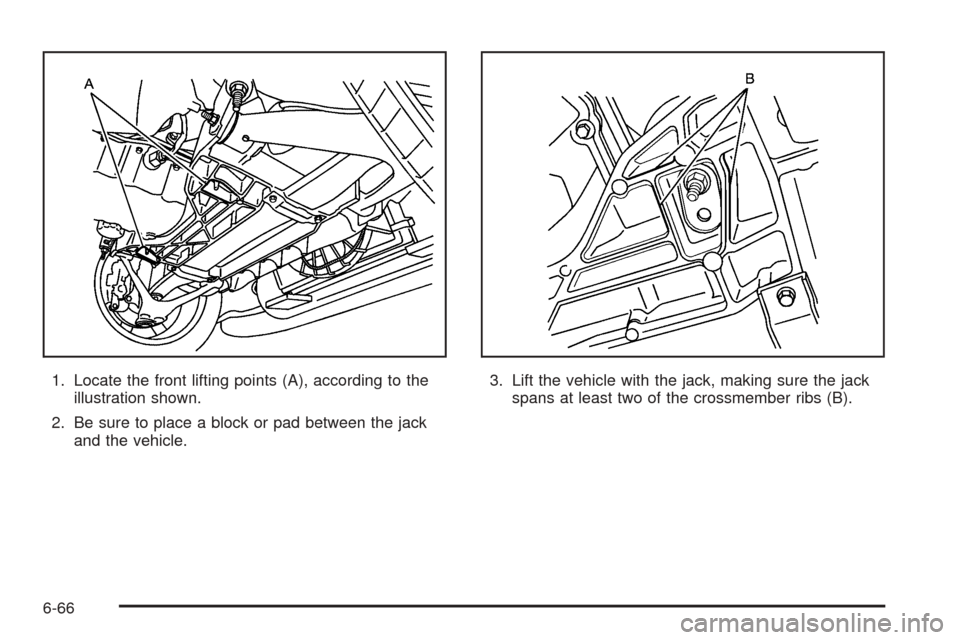
1. Locate the front lifting points (A), according to the
illustration shown.
2. Be sure to place a block or pad between the jack
and the vehicle.3. Lift the vehicle with the jack, making sure the jack
spans at least two of the crossmember ribs (B).
6-66
Page 375 of 438
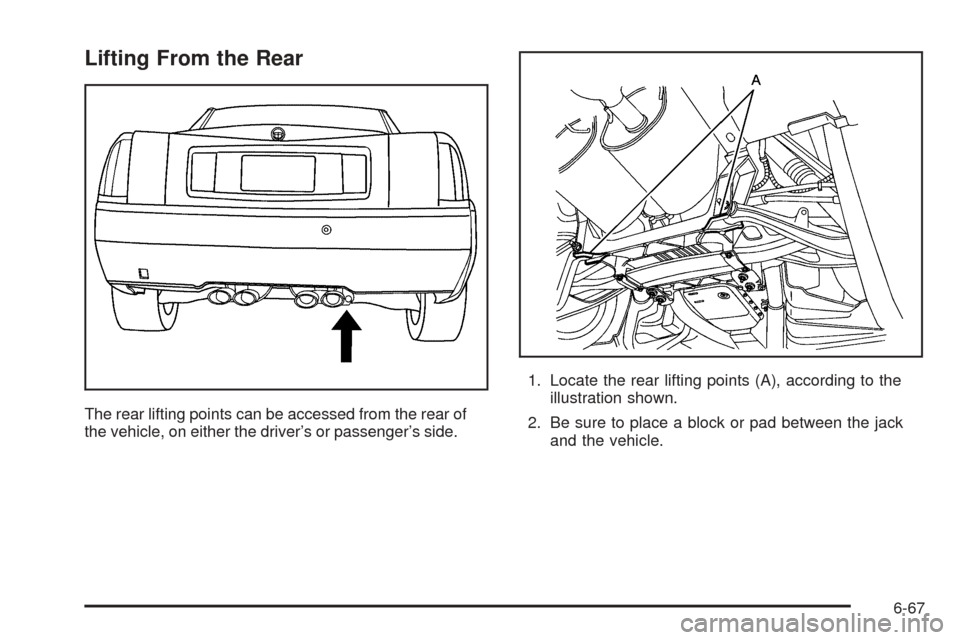
Lifting From the Rear
The rear lifting points can be accessed from the rear of
the vehicle, on either the driver’s or passenger’s side.1. Locate the rear lifting points (A), according to the
illustration shown.
2. Be sure to place a block or pad between the jack
and the vehicle.
6-67
Page 376 of 438
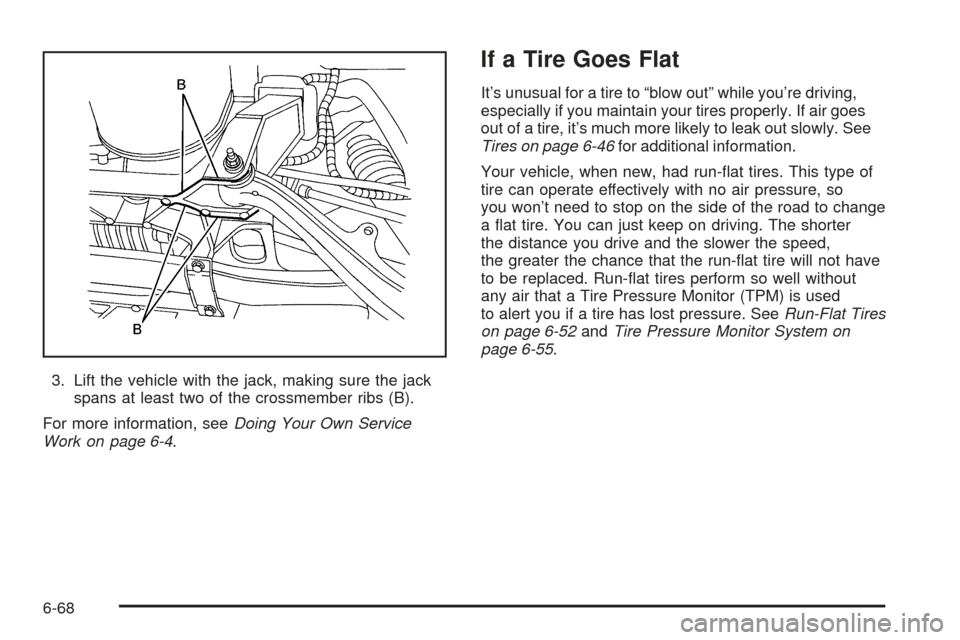
3. Lift the vehicle with the jack, making sure the jack
spans at least two of the crossmember ribs (B).
For more information, seeDoing Your Own Service
Work on page 6-4.
If a Tire Goes Flat
It’s unusual for a tire to “blow out” while you’re driving,
especially if you maintain your tires properly. If air goes
out of a tire, it’s much more likely to leak out slowly. See
Tires on page 6-46for additional information.
Your vehicle, when new, had run-�at tires. This type of
tire can operate effectively with no air pressure, so
you won’t need to stop on the side of the road to change
a �at tire. You can just keep on driving. The shorter
the distance you drive and the slower the speed,
the greater the chance that the run-�at tire will not have
to be replaced. Run-�at tires perform so well without
any air that a Tire Pressure Monitor (TPM) is used
to alert you if a tire has lost pressure. SeeRun-Flat Tires
on page 6-52andTire Pressure Monitor System on
page 6-55.
6-68
Page 377 of 438
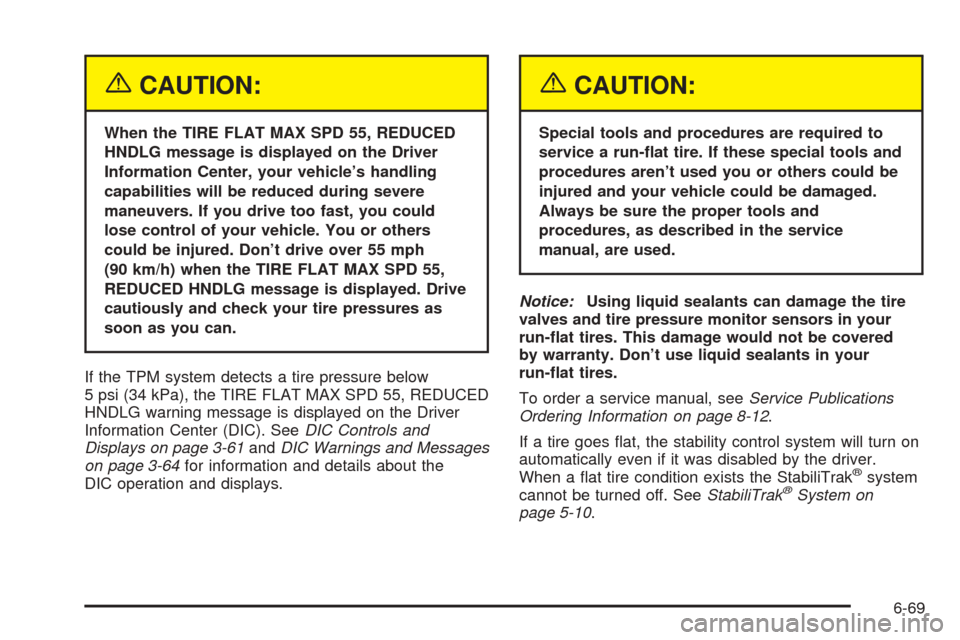
{CAUTION:
When the TIRE FLAT MAX SPD 55, REDUCED
HNDLG message is displayed on the Driver
Information Center, your vehicle’s handling
capabilities will be reduced during severe
maneuvers. If you drive too fast, you could
lose control of your vehicle. You or others
could be injured. Don’t drive over 55 mph
(90 km/h) when the TIRE FLAT MAX SPD 55,
REDUCED HNDLG message is displayed. Drive
cautiously and check your tire pressures as
soon as you can.
If the TPM system detects a tire pressure below
5 psi (34 kPa), the TIRE FLAT MAX SPD 55, REDUCED
HNDLG warning message is displayed on the Driver
Information Center (DIC). SeeDIC Controls and
Displays on page 3-61andDIC Warnings and Messages
on page 3-64for information and details about the
DIC operation and displays.
{CAUTION:
Special tools and procedures are required to
service a run-�at tire. If these special tools and
procedures aren’t used you or others could be
injured and your vehicle could be damaged.
Always be sure the proper tools and
procedures, as described in the service
manual, are used.
Notice:Using liquid sealants can damage the tire
valves and tire pressure monitor sensors in your
run-�at tires. This damage would not be covered
by warranty. Don’t use liquid sealants in your
run-�at tires.
To order a service manual, seeService Publications
Ordering Information on page 8-12.
If a tire goes �at, the stability control system will turn on
automatically even if it was disabled by the driver.
When a �at tire condition exists the StabiliTrak
®system
cannot be turned off. SeeStabiliTrak®System on
page 5-10.
6-69
Page 378 of 438
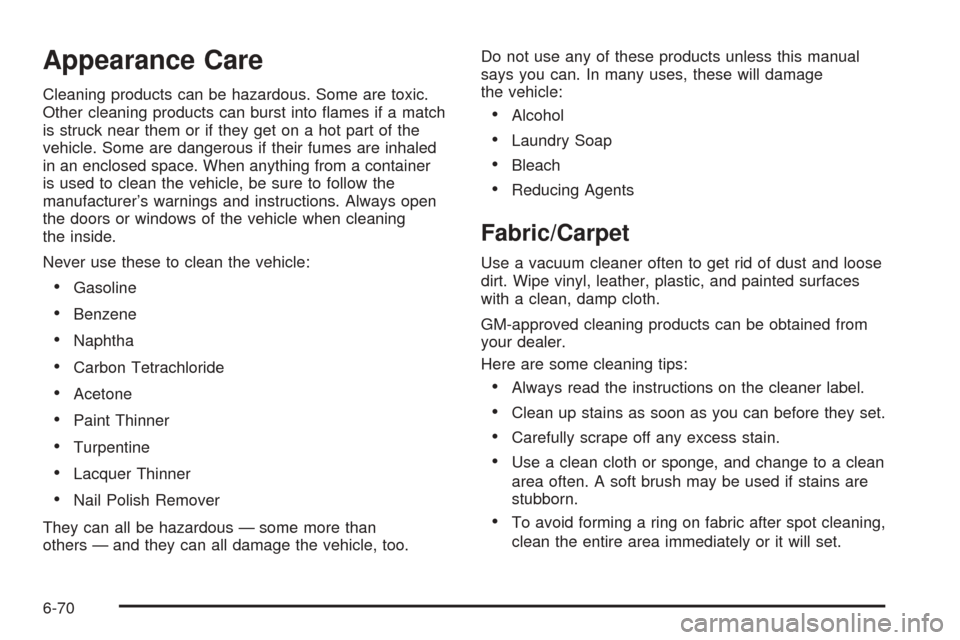
Appearance Care
Cleaning products can be hazardous. Some are toxic.
Other cleaning products can burst into �ames if a match
is struck near them or if they get on a hot part of the
vehicle. Some are dangerous if their fumes are inhaled
in an enclosed space. When anything from a container
is used to clean the vehicle, be sure to follow the
manufacturer’s warnings and instructions. Always open
the doors or windows of the vehicle when cleaning
the inside.
Never use these to clean the vehicle:
Gasoline
Benzene
Naphtha
Carbon Tetrachloride
Acetone
Paint Thinner
Turpentine
Lacquer Thinner
Nail Polish Remover
They can all be hazardous — some more than
others — and they can all damage the vehicle, too.Do not use any of these products unless this manual
says you can. In many uses, these will damage
the vehicle:
Alcohol
Laundry Soap
Bleach
Reducing Agents
Fabric/Carpet
Use a vacuum cleaner often to get rid of dust and loose
dirt. Wipe vinyl, leather, plastic, and painted surfaces
with a clean, damp cloth.
GM-approved cleaning products can be obtained from
your dealer.
Here are some cleaning tips:
Always read the instructions on the cleaner label.
Clean up stains as soon as you can before they set.
Carefully scrape off any excess stain.
Use a clean cloth or sponge, and change to a clean
area often. A soft brush may be used if stains are
stubborn.
To avoid forming a ring on fabric after spot cleaning,
clean the entire area immediately or it will set.
6-70
Page 379 of 438
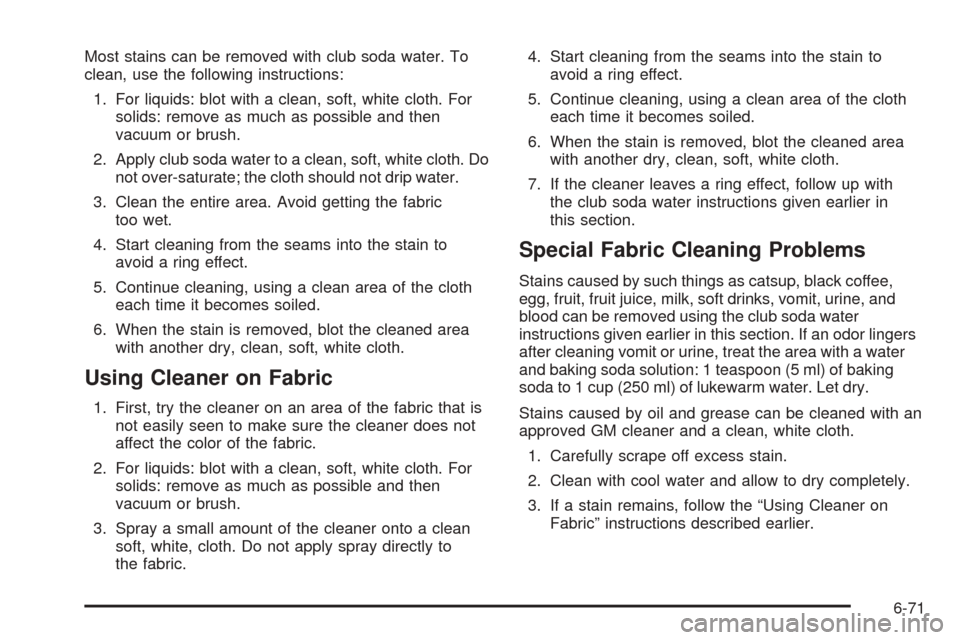
Most stains can be removed with club soda water. To
clean, use the following instructions:
1. For liquids: blot with a clean, soft, white cloth. For
solids: remove as much as possible and then
vacuum or brush.
2. Apply club soda water to a clean, soft, white cloth. Do
not over-saturate; the cloth should not drip water.
3. Clean the entire area. Avoid getting the fabric
too wet.
4. Start cleaning from the seams into the stain to
avoid a ring effect.
5. Continue cleaning, using a clean area of the cloth
each time it becomes soiled.
6. When the stain is removed, blot the cleaned area
with another dry, clean, soft, white cloth.
Using Cleaner on Fabric
1. First, try the cleaner on an area of the fabric that is
not easily seen to make sure the cleaner does not
affect the color of the fabric.
2. For liquids: blot with a clean, soft, white cloth. For
solids: remove as much as possible and then
vacuum or brush.
3. Spray a small amount of the cleaner onto a clean
soft, white, cloth. Do not apply spray directly to
the fabric.4. Start cleaning from the seams into the stain to
avoid a ring effect.
5. Continue cleaning, using a clean area of the cloth
each time it becomes soiled.
6. When the stain is removed, blot the cleaned area
with another dry, clean, soft, white cloth.
7. If the cleaner leaves a ring effect, follow up with
the club soda water instructions given earlier in
this section.
Special Fabric Cleaning Problems
Stains caused by such things as catsup, black coffee,
egg, fruit, fruit juice, milk, soft drinks, vomit, urine, and
blood can be removed using the club soda water
instructions given earlier in this section. If an odor lingers
after cleaning vomit or urine, treat the area with a water
and baking soda solution: 1 teaspoon (5 ml) of baking
soda to 1 cup (250 ml) of lukewarm water. Let dry.
Stains caused by oil and grease can be cleaned with an
approved GM cleaner and a clean, white cloth.
1. Carefully scrape off excess stain.
2. Clean with cool water and allow to dry completely.
3. If a stain remains, follow the “Using Cleaner on
Fabric” instructions described earlier.
6-71
Page 380 of 438
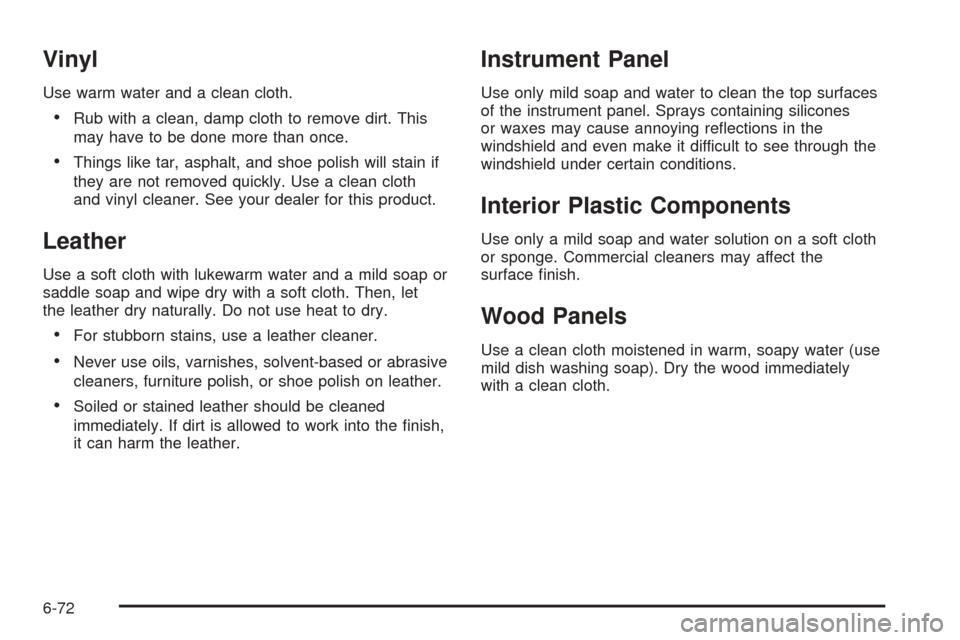
Vinyl
Use warm water and a clean cloth.
Rub with a clean, damp cloth to remove dirt. This
may have to be done more than once.
Things like tar, asphalt, and shoe polish will stain if
they are not removed quickly. Use a clean cloth
and vinyl cleaner. See your dealer for this product.
Leather
Use a soft cloth with lukewarm water and a mild soap or
saddle soap and wipe dry with a soft cloth. Then, let
the leather dry naturally. Do not use heat to dry.
For stubborn stains, use a leather cleaner.
Never use oils, varnishes, solvent-based or abrasive
cleaners, furniture polish, or shoe polish on leather.
Soiled or stained leather should be cleaned
immediately. If dirt is allowed to work into the �nish,
it can harm the leather.
Instrument Panel
Use only mild soap and water to clean the top surfaces
of the instrument panel. Sprays containing silicones
or waxes may cause annoying re�ections in the
windshield and even make it difficult to see through the
windshield under certain conditions.
Interior Plastic Components
Use only a mild soap and water solution on a soft cloth
or sponge. Commercial cleaners may affect the
surface �nish.
Wood Panels
Use a clean cloth moistened in warm, soapy water (use
mild dish washing soap). Dry the wood immediately
with a clean cloth.
6-72